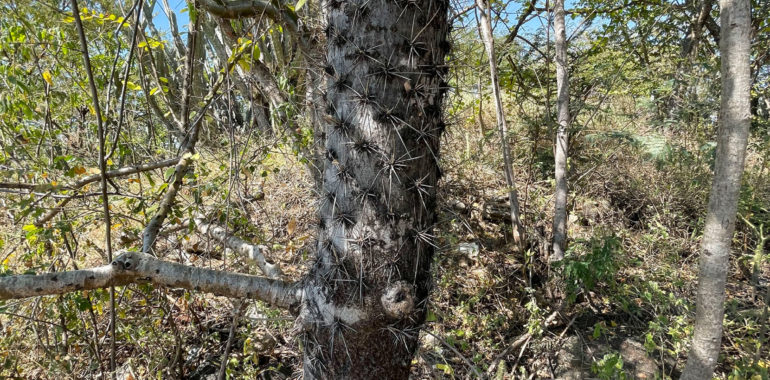Cacti are perennial plants, very attractive for their strange shapes and spines. Its stems are green, fleshy, simple or branched, with cylindrical, globose, or flattened shapes. They are, generally, terrestrial plants adapted to extreme climates where they can survive long periods without water. They can be herbs, shrubby or arborescent, fleshy or even hard and woody stems; also, epiphytes cacti can be found (mostly in trees from the tropical zones). The main characteristic of cacti is the presence of thorns (spines) on their stems instead of leaves, in fact, the word cactus derives from the Greek “káctos”, which means “prickly thistle”. But, as nature is unpredictable, there’s the exception of the rule: two genera which species have leaves.These are: Pereskia and Pereskiopis. So, if you are a cactus enthusiast, you will surely be impressed by learning about the species Pereskia lychnidiflora.
At first glance, Pereskia lychnidiflora looks like a tree full of thorns, since it can reach up to 9 meters in height and its stems are even woody-like, so you would never imagine that it is a cactus. This species is commonly found in the dry forest of Guatemala, which includes the departments of El Progreso, Zacapa and Chiquimula. It is known by the locals by the name of “Manzanote” due to the fruits it produces, very similar to apples (big apple in Spanish). There is a special interest in the Pereskia genus because of its medicinal properties such as antisyphilitic, emollient and for the treatment of inflammatory and skin diseases. Recent research has shown that the P. lychnidiflora species contains anti-inflammatory and analgesic properties due to the presence of tannin alkaloids and sterols.


The characteristics of Pereskia lychnidiflora make it a very interesting and exotic plant, but at the same time, very little studied and appreciated. It is a sample of the great diversity of species that we can find in the dry forest, a unique place in Guatemala; but very few people talk about it because the tree species that live there lose their foliage for 5 to 6 months, water is scarce due to lack of rain and therefore, it is quite hot in the dry season. On the other side, the seasonally dry forest can be a real spectacle in the rainy season, first because trees recover their foliage and transform into the forest we expect to see. Plus, there are many reptiles and insects resting on these trees which complement the landscape. (read our blog about the most eccentric lizard from Guatemala)
Next opportunity (once the Coronavirus lockdown is over) you have to pass through the Motagua Valley, pay more attention and maybe you will observe this interesting species: Pereskia lychnidiflora, one of the only cacti that have leaves.
To learn more about biodiversity in Guatemala and the Mesoamerican region, go visit our websites: www.maya-ethnobotany.orgwww.maya-ethnozoology.org
BIBLIOGRAPHY
- 2018
- Efecto analgésico, caracterización fitoquímica y análisis toxicológico
del extracto etanólico de hojas de Pereskia lychnidiflora. Rev. perú. med. exp. salud publica vol.35 no.4. - 2008
- Las Cactáceas de Guatemala. Escuela de Biología Facultad de
Ciencias Químicas y Farmacia Universidad de San Carlos de Guatemala, Guatemala. 134 pags.Downloadable:
http://cdc.usac.edu.gt/wp-content/uploads/2019/06/LasCactceasdeGuatemala.pdf - 2017
- El bosque estacionalmente seco de Guatemala: Flora, Fauna y
Cultura.
First posted, January 2021
Note by Vivian Hurtado, FLAAR Mesoamerica (Guatemala).

